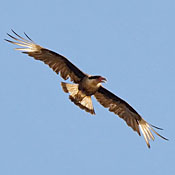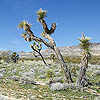Crested Caracara
Caracara cheriway

Hawk Like

Length: 23 in. (58 cm )
The national bird of Mexico, this large falcon occurs in open, arid brushlands, pastures, and deserts. It feeds largely on carrion, especially along roads where mammals and birds killed by vehicles are often available. Given the opportunity, it will also feed on fish, eggs, reptiles, and insects. It often uses its long legs to run after prey as well as dig into the soil. Its huge nest is made of sticks and placed high in an isolated tree or saguaro cactus.
The four-digit banding code is CRCA.
Bibliographic details:
- Article: Crested Caracara
- Author(s): Dr. Biology
- Publisher: Arizona State University School of Life Sciences Ask A Biologist
- Site name: ASU - Ask A Biologist
- Date published:
- Date accessed:
- Link: https://askabiologist.asu.edu/activities/bird/crested-caracara
APA Style
Dr. Biology. (). Crested Caracara. ASU - Ask A Biologist. Retrieved from https://askabiologist.asu.edu/activities/bird/crested-caracara
Chicago Manual of Style
Dr. Biology. "Crested Caracara". ASU - Ask A Biologist. . https://askabiologist.asu.edu/activities/bird/crested-caracara
Dr. Biology. "Crested Caracara". ASU - Ask A Biologist. . ASU - Ask A Biologist, Web. https://askabiologist.asu.edu/activities/bird/crested-caracara
MLA 2017 Style
Be Part of
Ask A Biologist
By volunteering, or simply sending us feedback on the site. Scientists, teachers, writers, illustrators, and translators are all important to the program. If you are interested in helping with the website we have a Volunteers page to get the process started.






